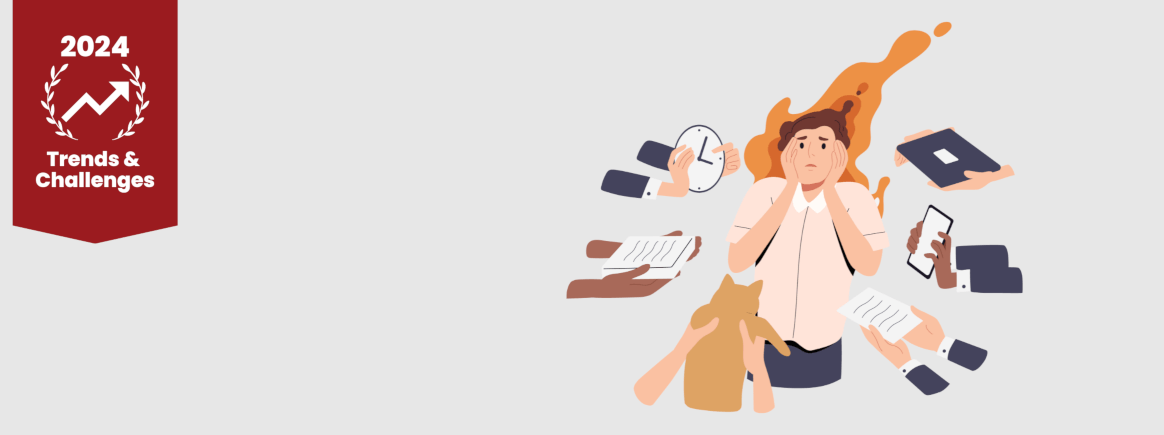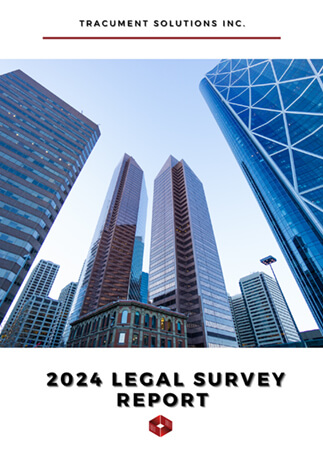
Burnout in the Legal Industry
Let's delve into a topic that has garnered significant attention within office environments across Canada — burnout. Yup, that feeling of being drained, stressed, and just plain exhausted from the grind and endless emails. According to our recent survey, it's hitting the legal industry hard, with half of legal professionals feeling the burnout blues. It's so bad that nearly three-quarters are ready to pack up and leave their jobs because of it. Yikes!
The National Study on the Health & Wellness Determinants of Legal Professionals in Canada found that 55% of legal professionals experience burnout. So, what's the deal? Why are so many professionals still feeling like they're running on empty?
The Burnout Epidemic
Well, it's no secret that the legal world is fast-paced and demanding. Juggling caseloads, tight deadlines, and the pressure to perform can take its toll. As one of our participants put it, “The adversarial nature of legal practice, coupled with high responsibility levels and billable hour expectations, amplifies stress”. Finding a balance between work and personal life is important and a key consideration for young professionals thinking about their future according to our survey of early-career individuals in the legal field.
Strategies for Employers
Burnout is a long standing issue within the legal profession that warrants serious attention. However, what strategies can employers implement to effectively begin to address this issue?
We recommend the following:
-
Better Workload Distribution:
One of the primary factors contributing to burnout is an overwhelming workload. Employers must implement strategies to ensure equitable distribution of tasks, avoiding overburdening specific individuals or teams. Encouraging collaboration, regular workload assessments and leveraging technology tools such as project management software are a few ways employers can promote a more balanced workload distribution.
-
Cultivating Supportive Environments:
Toxic work environments exacerbate burnout symptoms and drive talented professionals away. A participant emphasized this by stating, "Misery loves company. Having unhappy employees decreases the overall vibe in an office. It only takes one unhappy employee to create friction in an otherwise healthy environment". Employers can start by establishing clear boundaries around after-hours communication and providing access to mental health resources such as counselling services or mindfulness programs.
-
Flexible Work Arrangements:
With the rise of remote work, employers have the opportunity to embrace telecommuting and flexible work hours more than ever before. This includes allowing employees to set their own work hours, within certain parameters, which can enable them to distribute their workload more effectively and can empower employees to achieve a better work-life balance. By accommodating individual needs and preferences, employers demonstrate their commitment to employee well-being.
-
Investing in Mental Health Resources:
Dealing with emotionally charged cases, conflict, and difficult clients can be emotionally draining for legal professionals. Lawyers may experience compassion fatigue, vicarious trauma, and moral distress as they navigate challenging legal scenarios. Over time, exposure to such emotional stressors can erode mental resilience and increase the risk of burnout. Employers must recognize the importance of mental health support and invest in resources such as counselling services, mindfulness programs, and stress management workshops. Law firms can also improve mental health in the office through a variety of creative means including
-
Wellness Rooms: Where employees can take short breaks to meditate, practice mindfulness, or simply relax away from their desks.
-
Fitness Subsidies or In-House Gyms: Regular exercise is crucial for maintaining good mental health, and offering convenient access to fitness options can encourage employees to prioritize physical activity.
-
Colour Psychology/Green Spaces: Strategically incorporate colours that evoke positive emotions and promote productivity. For example, soft shades of blue can instill a sense of calm and focus, while pops of yellow or green can inspire creativity and energy. Research also shows that exposure to greenery can reduce stress and improve overall well-being.
-
Customizable Workstations: Allow employees to personalize their space according to their preferences and personality. Encourage the use of desk accessories, artwork, and decor items that spark joy and reflect individual identities.
By destigmatizing mental health issues and providing accessible resources, firms can help employees cope with the pressures of the legal profession.
-
Despite the prevalence of mental health challenges in the legal profession, there is often a stigma associated with acknowledging and seeking help for mental health issues. Fear of judgment, concerns about professional reputation, and perceived weakness can prevent lawyers from accessing support. However, by making steps to prioritize work-life balance and implement proactive strategies, employers can mitigate burnout risk and foster a healthier, more resilient workforce.
There is a significant distinction between a challenging work environment and a toxic one. — Firm Partner 35-50
Take a moment to reflect on your own experiences. How do you prioritize your well-being amidst the demands of your profession? What additional steps can your office take to contribute to the well-being of its employees?
You may also like
Happy Holidays Message from David Swadden, CEO
December 18, 2025
We would like to wish all our clients and readers a wonderful holiday season filled with joy and laughter.
Tracument Holiday Schedule
December 11, 2025
We would like to update all our clients of our Holiday Schedule this holiday season!
Tracument Wrapped!
December 4, 2025
What 2025 Looked like for Tracument and for you!




